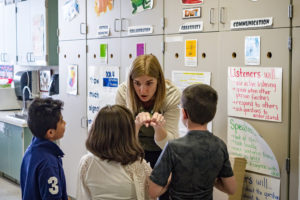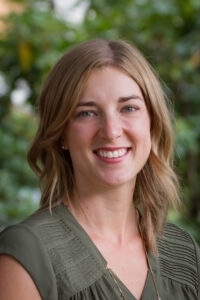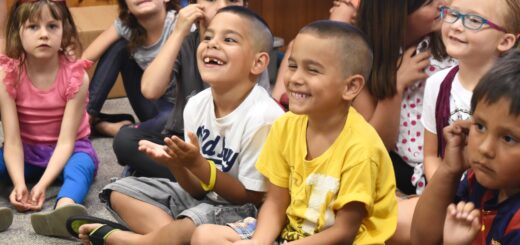Honored Quincy teacher Camille Jones champions finding, nurturing student talents
QUINCY — Camille Jones, the Quincy educator who was named 2017 regional and state teacher of the year, embodies the attitude and mindset of the many outstanding teachers in our schools.
The STEAM (Science, Technology, Engineering Arts and Math) specialist at Pioneer Elementary School is devoted to discovering the talents and capabilities in each student, encouraging and pushing those students to develop their unique abilities as well as their development as caring human beings. She teaches STEAM for all 450 students in the kindergarten through third grades.
Recently, I had the opportunity to interview Jones, 32, with the assistance of Veronique Paquette, the outstanding second-grade teacher from Kenroy Elementary in East Wenatchee. Our objective is to discover the secrets of great teaching and share those with parents, teachers and administrators across the region.
We recorded our conversation for my Art of Community NCW podcast, which can be accessed at artofcommunityncw.com. During our interview, Jones was joined by her 7-month-old daughter Eleanor, who added a lively dimension to our conversation.
At Pioneer Elementary, there has been a concentrated effort by the entire staff to discover the unique talents of each student and find ways to encourage them to develop those gifts. At the same time, the school has expanded opportunities for the students to have enriching experiencing. These efforts have led to significant improvements that have unlocked the hidden potential of many students.
Jones recalls that a few years ago, only three individuals in the school (all Anglos) were identified as highly capable, despite the fact that the school is 90 percent Latino. Jones said it didn’t make sense that none of the Latino students were highly capable. The approach being used was missing a significant number of gifted students.
By maintaining high standards while doing more effective job of identifying these talents, the number of highly capable students is now 70 percent Latino. That’s quite a transformation.
For example, Jones was teaching an engineering unit and asked the students to build bridges using the materials in the classroom. While most of the kids used blocks to build bridges, one second-grader created an arched bridge out of Legos in just a few minutes. “It was just way more complicated and complex than anyone else had been working on,” Jones marveled.
It turns out the student was learning English and was doing all right with math but struggling to read.
With the support of his regular teacher, Jones had the student join an advanced engineering project and from the first day, “he was the clear leader in that class,” Jones said. As a final class project, the students constructed popcorn carts out of Legos. “Not only did he have the working gear mechanism for the sign, but he’d created an entirely separate gear system that was the actual popcorn popper,” that shot out yellow Legos, she added.
Once this talent was valued and appreciated, his confidence improved and he quickly started improving his reading and speaking ability. “It was just amazing to see the change in his attitude,” Jones recalled.
This effort to identify talents is a total school effort. “I have a school full of teachers that have the same philosophy about our students — that they have potential and we want to help them build on it,” Jones added.
This school-wide emphasis on identifying student strengths is challenging, she acknowledged. The national and state policy emphasis in recent years has been on assessing kids continually to the point that many districts narrow the curriculum to a basic level.
In the Quincy School District and at Pioneer Elementary, said Jones, they’re bucking that approach and broadening the opportunities for students. “I just appreciate working in a school and in a community that has done that for many, many years,” said Jones. Enrichment is for everybody in that district.
This focus on expanding opportunities is something that Jones is passionate about encouraging in schools throughout the region.
Her experiences as regional and state teacher of the year gave her a deep understanding of how policy is made as well as connected her with great educators around nation. The experiences have improved her teaching and given her confidence to speak out about changes that need to be made in education.
She’ll be sharing her wisdom through a blog on the Corelaborate website, which was created by teachers to promote and support innovative instruction. Check it out at corelaboratewa.org.
As a final question, I asked Jones to tell me a few of the things she’s most grateful for in her life. She replied, “Right now, I’m most grateful to have a baby that is a good sleeper. I am grateful that I get to teach in a role that lets me seek out and build on students’ strengths, and introduce them to new experiences and opportunities. I am grateful that my principal and district administrators believe in me and support me in my work and I’m grateful for my students, because they fill me with hope every day.”
Recently, I had the opportunity to interview Jones, 32, with the assistance of Veronique Paquette, the outstanding second-grade teacher from Kenroy Elementary in East Wenatchee. Our objective is to discover the secrets of great teaching and share those with parents, teachers and administrators across the region.
We recorded our conversation for my Art of Community NCW podcast, which can be accessed at artofcommunityncw.com. During our interview, Jones was joined by her 7-month-old daughter Eleanor, who added a lively dimension to our conversation.
At Pioneer Elementary, there has been a concentrated effort by the entire staff to discover the unique talents of each student and find ways to encourage them to develop those gifts. At the same time, the school has expanded opportunities for the students to have enriching experiencing. These efforts have led to significant improvements that have unlocked the hidden potential of many students.
Jones recalls that a few years ago, only three individuals in the school (all Anglos) were identified as highly capable, despite the fact that the school is 90 percent Latino. Jones said it didn’t make sense that none of the Latino students were highly capable. The approach being used was missing a significant number of gifted students.
By maintaining high standards while doing more effective job of identifying these talents, the number of highly capable students is now 70 percent Latino. That’s quite a transformation.
For example, Jones was teaching an engineering unit and asked the students to build bridges using the materials in the classroom. While most of the kids used blocks to build bridges, one second-grader created an arched bridge out of Legos in just a few minutes. “It was just way more complicated and complex than anyone else had been working on,” Jones marveled.
It turns out the student was learning English and was doing all right with math but struggling to read.
With the support of his regular teacher, Jones had the student join an advanced engineering project and from the first day, “he was the clear leader in that class,” Jones said. As a final class project, the students constructed popcorn carts out of Legos. “Not only did he have the working gear mechanism for the sign, but he’d created an entirely separate gear system that was the actual popcorn popper,” that shot out yellow Legos, she added.
Once this talent was valued and appreciated, his confidence improved and he quickly started improving his reading and speaking ability. “It was just amazing to see the change in his attitude,” Jones recalled.
This effort to identify talents is a total school effort. “I have a school full of teachers that have the same philosophy about our students — that they have potential and we want to help them build on it,” Jones added.
This school-wide emphasis on identifying student strengths is challenging, she acknowledged. The national and state policy emphasis in recent years has been on assessing kids continually to the point that many districts narrow the curriculum to a basic level.
In the Quincy School District and at Pioneer Elementary, said Jones, they’re bucking that approach and broadening the opportunities for students. “I just appreciate working in a school and in a community that has done that for many, many years,” said Jones. Enrichment is for everybody in that district.
This focus on expanding opportunities is something that Jones is passionate about encouraging in schools throughout the region.
Her experiences as regional and state teacher of the year gave her a deep understanding of how policy is made as well as connected her with great educators around nation. The experiences have improved her teaching and given her confidence to speak out about changes that need to be made in education.
She’ll be sharing her wisdom through a blog on the Corelaborate website, which was created by teachers to promote and support innovative instruction. Check it out at corelaboratewa.org.
As a final question, I asked Jones to tell me a few of the things she’s most grateful for in her life. She replied, “Right now, I’m most grateful to have a baby that is a good sleeper. I am grateful that I get to teach in a role that lets me seek out and build on students’ strengths, and introduce them to new experiences and opportunities. I am grateful that my principal and district administrators believe in me and support me in my work and I’m grateful for my students, because they fill me with hope every day.”
This is the second in a series of columns about outstanding educators in North Central Washington, an idea conceived by Veronique Paquette of Kenroy Elementary.







